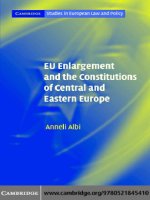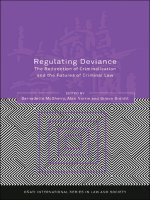banking and the management of financial institutions
Bạn đang xem bản rút gọn của tài liệu. Xem và tải ngay bản đầy đủ của tài liệu tại đây (177.4 KB, 37 trang )
Copyright 2011
Pearson Canada Inc.
13 -
1
Chapter 13
Banking and the Management
of Financial Institutions
Copyright 2011
Pearson Canada Inc.
13 -
2
Assets
•
Cash reserves
•
Deposits at Other Banks
•
Cash Items in Process of Collection
•
Securities
•
Loans
•
Fixed and Other Assets
Copyright 2011
Pearson Canada Inc.
13 -
3
Liabilities I
•
Demand and Notice Deposits
•
Fixed – Term Deposits
•
Borrowings
–
Overdraft loans (advances)
–
Settlement balances
•
Bank capital
•
Reserves
–
Vault cash
–
Desired reserves
–
Banker’s risk
–
Desired reserve ratio
Copyright 2011
Pearson Canada Inc.
13 -
4
Liabilities II
•
Cash Items in Process of Collection
–
Items in transit (bank float)
•
Deposits at Other Banks
–
Interbank deposits
•
Securities
–
Secondary reserves
•
Loans
•
Other Assets
Copyright 2011
Pearson Canada Inc.
13 -
5
The Bank Balance Sheet
Copyright 2011
Pearson Canada Inc.
13 -
6
Basic Banking I
•
Opening of a checking account leads to an increase in
the bank’s reserves equal to the increase in chequable
deposits
First Bank Business
Assets Liabilities Assets Liabilities
Loans +$100 Chequable
deposits
+$100 Chequable
Deposits
+$100 Bank Loans +$100
First bank makes a loan of $100 to a business and
credits the business's chequable deposit.
Copyright 2011
Pearson Canada Inc.
13 -
7
Basic Banking II
First Bank Second Bank
Assets Liabilities Assets Liabilities
Reserves +$100 Chequable
deposits
+$100 Reserves -$100 Chequable
deposits
-$100
First Bank
Assets Liabilities
Cash items in
process of
collection
+$100 Chequable
deposits
+$100
When a bank receives
additional deposits, it
gains an equal amount
of reserves: when it
loses deposits, it loses
an equal amount of
reserves
Copyright 2011
Pearson Canada Inc.
13 -
8
Basic Banking—Making a Profit
•
Asset transformation-selling liabilities with one set of
characteristics and using the proceeds to buy assets with a
different set of characteristics
•
The bank borrows short and lends long
First Bank First Bank
Assets Liabilities Assets Liabilities
Desired
reserves
+$100 Chequable
deposits
+$100 Desired
reserves
+$10 Chequable
deposits
+$100
Excess
reserves
+$90 Loans +$90
Copyright 2011
Pearson Canada Inc.
13 -
9
Bank Management
•
Liquidity Management
•
Asset Management
•
Liability Management
•
Capital Adequacy Management
•
Credit Risk
•
Interest-rate Risk
Copyright 2011
Pearson Canada Inc.
13 -
10
Liquidity Management and the Role of
Reserves
•
If a bank has ample excess reserves, a deposit outflow
does not necessitate changes in other parts of its
balance sheet
Assets Liabilities Assets Liabilities
Reserves $20M Deposits $100M Reserves $10M Deposits $90M
Loans $80M Bank
Capital
$10M Loans $80M Bank Capital $10M
Securities $10M Securities $10M
with deposit outflow of $10
million
↓
Copyright 2011
Pearson Canada Inc.
13 -
11
Liquidity Management: Shortfall in
Reserves
•
Reserves are now short of the desired amount and the
shortfall must be eliminated
•
Excess reserves are insurance against the costs
associated with deposit outflows
Assets Liabilities Assets Liabilities
Reserves $10M Deposits $100M Reserves $0 Deposits $90M
Loans $90M Bank
Capital
$10M Loans $90M Bank Capital $10M
Securities $10M Securities $10M
with deposit outflow of $10
million
↓
Copyright 2011
Pearson Canada Inc.
13 -
12
Liquidity Management: Borrowing
•
Cost incurred is the interest rate paid on the
borrowed funds
Assets Liabilities
Reserves $9M Deposits $90M
Loans $90M Borrowing $9M
Securities $10M Bank Capital $10M
Borrowing $9 million from other banks
Copyright 2011
Pearson Canada Inc.
13 -
13
Liquidity Management: Securities Sale
•
The cost of selling securities is the brokerage and
other transaction costs
Assets Liabilities
Reserves $9M Deposits $90M
Loans $90M Bank Capital $10M
Securities $1M
Can meet shortfall by reducing loans by $9 million
Copyright 2011
Pearson Canada Inc.
13 -
14
Liquidity Management:
Bank of Canada Advances
•
Borrowing from the Bank of Canada also incurs
interest payments based on the discount rate
Assets Liabilities
Reserves $9M Deposits $90M
Loans $90M Advance Bank of
Canada
$9M
Securities $10M Bank Capital $10M
Borrow $9 million from the Bank of Canada
Copyright 2011
Pearson Canada Inc.
13 -
15
Liquidity Management: Reduce Loans
•
Reduction of loans is the most costly way of
acquiring reserves
•
Calling in loans antagonizes customers
•
Other banks may only agree to purchase loans at a
substantial discount
Assets Liabilities
Reserves $9M Deposits $90M
Loans $81M Bank Capital $10M
Securities $10M
Copyright 2011
Pearson Canada Inc.
13 -
16
Asset Management: Three Goals
•
Seek the highest possible returns on loans and
securities
•
Reduce risk
•
Have adequate liquidity
Copyright 2011
Pearson Canada Inc.
13 -
17
Asset Management: Four Tools
•
Find borrowers who will pay high
interest rates and have low possibility
of defaulting
•
Purchase securities with high returns and low
risk
•
Lower risk by diversifying
•
Balance need for liquidity against increased
returns from less liquid assets
Copyright 2011
Pearson Canada Inc.
13 -
18
Liability Management
•
Recent phenomenon due to rise of money
center banks
•
Expansion of overnight loan markets and new
financial instruments (such as negotiable CDs)
•
Checkable deposits have decreased in
importance as source of bank funds
Copyright 2011
Pearson Canada Inc.
13 -
19
Capital Adequacy Management
•
Bank capital helps prevent bank failure
•
The amount of capital affects return for the
owners (equity holders) of the bank
•
Regulatory requirement
Copyright 2011
Pearson Canada Inc.
13 -
20
Capital Adequacy Management: Preventing Bank Failure
High Bank Capital Low Bank Capital
Assets Liabilities Assets Liabilities
Reserves $10M Deposits $90M Reserves $10M Deposits $96M
Loans $90M Bank Capital $10M Loans $90M Bank Capital $4M
High Bank Capital Low Bank Capital
Assets Liabilities Assets Liabilities
Reserves $10M Deposits $90M Reserves $10M Deposits $96M
Loans $85M Bank Capital $5M Loans $85M Bank Capital -$1M
Copyright 2011
Pearson Canada Inc.
13 -
21
Capital Adequacy Management: Returns to Equity Holders
EM x ROA ROE
capital equity
assets
assets
taxes after profit net
capital equity
taxes after profit net
Capital Equity
Assets
EM
capital equityof dollar per assetsof amount the :Multiplier Equity
the by expressed is ROE and ROA between ipRelationsh
capital equity
taxes after profit net
ROE
capital equityof dollar per taxes after profit net:Equity on Return
assets
taxes after profit net
ROA
assetsof dollar per taxes after profit net:Assets on Return
=
=
=
=
=
x
Copyright 2011
Pearson Canada Inc.
13 -
22
Capital Adequacy Management: Safety
•
Benefits the owners of a bank by making their
investment safe
•
Costly to owners of a bank because the higher
the bank capital, the lower the return on
equity
•
Choice depends on the state of the economy
and levels of confidence
•
Bank capital requirement
Copyright 2011
Pearson Canada Inc.
13 -
23
Strategies for Managing Bank Capital
Lowering Bank Capital:
•
Buying back some of Bank’s stock
•
Pay out higher dividend to shareholders
•
Acquire new funds and increase assets
Raising Bank Capital:
•
Issue more common stock
•
Reducing dividend to shareholders
•
Issue fewer loans or sell securities and use proceeds
to reduce liabilities
Copyright 2011
Pearson Canada Inc.
13 -
24
Managing Credit Risk I
•
A major component of many financial
institutions business is making loans
•
To make profits, these firms must make
successful loans that are paid back in full
•
The concepts of moral hazard and adverse
selection are useful in explaining the risks
faced when making loans
Copyright 2011
Pearson Canada Inc.
13 -
25
Managing Credit Risk II
•
Adverse selection is a problem in loan markets
because bad credit risks (those likely to
default) are the one which usually line up for
loans
•
Those who are most likely to produce an
adverse outcome are the most likely to be
selected









